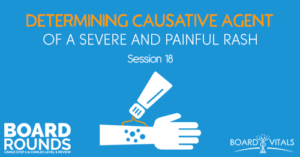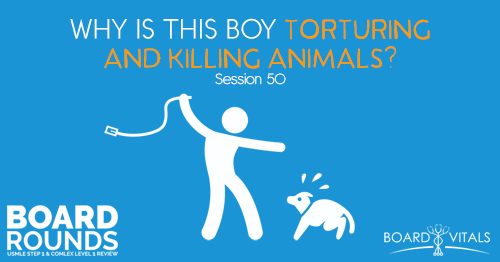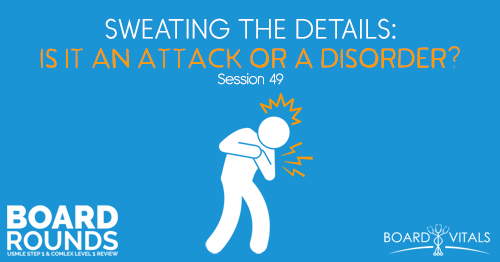Apple Podcasts | Google Podcasts

Session 18
As always, I’m joined by Dr. Karen Shackelford from Board Vitals. If you haven’t yet, check out Board Vitals and use the promo code BOARDROUNDS to save 15%. They have a huge database and question bank to help you get the practice you need to get the score that you need.
[01:35] Question of the Week
An older patient comes in with a painful rash. We have a 64-year-old female who presents complaining of a severe painful rash that is localized to the left side of her upper back and neck. She knows that the area of the rash feels hot and burning and extremely painful.
She is otherwise healthy with no significant past medical history. On exam, her vital signs were within normal limits. And her exam is significant, primarily, because she has a large, red vesicular rash running along her left shoulder in confluent patches. She remarks that the lesions were smaller a few days ago and they quickly start to bubble over into larger 02:39. The physician performed a Tzanck smear to confirm her suspicions.
She found the test to be positive for multinucleated giant cells. The patient will have which of the following characteristics?
(A) Gram-positive, catalase-positive, beta-hemolytic and arranged in clusters
(B) Branching pseudohyphae with budding yeast cells
(C) Enveloped-virus with double-stranded DNA
(D) Enveloped-virus with positive-strand RNA virus
[04:30] Thought Process
The correct answer is C. Varicella zoster virus would probably come to mind as well as shingles as the Tzanck smear showed multinucleated giant cells – herpes simplex virus 1 and 2 (HSV 1 and 2) as well as pemphigus vulgaris. Other findings you would probably see on the Tzanck smear would include acantholytic cell and keratinocyte ballooning.
This test is not typically performed usually as a clinical diagnosis. But it can be performed in the office. The patient can be immunocompromised with atypical looking lesion or atypical presentation. So we’d think of herpes and varicella zoster.
For the other answer choices, Choice A is Staphylococcus aureus, which isn’t a choice for a skin infection.
Choice B is a fungus. A fungal disease like Candida can cause a really nasty rash. But it won’t be the vesicular nor the dermatomal, which this question suggests.
Varicella zoster virus is latent in the sensory ganglion so it tends to erupt on one or two contiguous dermatomes, although it can erupt outside of the dermatome. But it’s not going to be a big eruption and just one or two vesicles scattered somewhere else from reactivation of the viral particles.
Option D is Rubella. It causes a rash and it’s usually tested for IgM antibodies. If a test is needed, it’s not the Tzanck smear.
[07:45] Possible Question Points About the Herpes Virus
About 30% of Americans will have it at some point in their lives coming from reactivation of the virus. It causes two clinically distinct diseases including chicken pox.
Chicken pox would be characterized by vesicular lesions but they’re on different stages of development. They’re concentrated on the face and the trunk. It’s an airborne virus that invades the lymphoid tissue in the nose or nasopharynx.
The virus overcomes local host defenses. The epidermal cells usually react by making alpha-interferons. That’s the incubation period.
When the virus can overcome the local host defenses, then you’ve got a viremia. Then the virus downregulates your immune response through a variety of mechanisms, such as the inhibition of the expression of interferon response genes.
When the virus remains latent for years in most cases, you’re more at risk of reactivation as you get older because you have a diminished T-cell response.
This is the same reason that people with immuno-compromise are more likely to erupt with shingles. It’s a unilateral vesicular eruption, usually in the dermatome.
The reactivated varicella can travel either way. It can travel peripherally through the sensory ganglion and go down the sensory nerve. This results in a skin infection or the characteristic rash.
It can also reactivate and move centrally from the ganglion. This is seen in those who are severely immuno-compromised. But this results in some of the complications associated with herpes zoster like meningitis-encephalitis.
Some of the syndromes include the Ramsay Hunt syndrome but it’s a random thing. It occurs whenever the virus replicates in the geniculate ganglion. It travels down the 8th nerve and you have vesicles on the auricle or in the ear canal – ipsilateral facial paralysis.
Herpes 11:12 is a pretty significant complication. You have to recognize it really early on because it can cause blindness. You can get herpes keratitis and acute retinal nephrosis. The treatment is going to be an antiviral ganciclovir or acyclovir.
Postherpetic neuralgia is another big complication with severe significant pain (3 out of 10 and higher for about 90 days or more). Some people can have sensory changes. It can be intensely pruritic.
If you get vesicular lesions on the nose then the nerve distribution is pretty worrisome so you have to be aware of that.
[12:50] Board Vitals
Check out Board Vitals and use the promo code BOARDROUNDS to save 15% off your QBank purchase. Whether you’re studying for the COMPLEX or USMLE, Board Vitals has the QBank you need to help prepare you the best possible way.
Links:
Board Vitals (use the promo code BOARDROUNDS to save 15%)
SEARCH SITE
LISTEN FOR FREE











